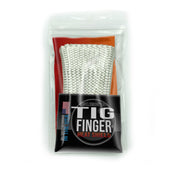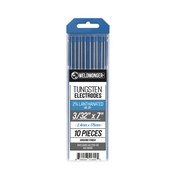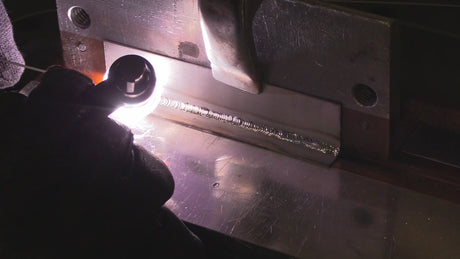I made this video on tungsten sharpening that included some tips for cutting tungsten with or without a tungsten grinder.
I understand not everyone needs a precision tungsten grinder like this CK worldwide Turbo sharp but I also know that if you are doing precision high end work, it will be very helpful.
I included some real world methods I have used for tungsten sharpening compared to using a CK tungsten grinder because I know not everyone can afford a tungsten sharpener. ( but let me also say that the CK turbo sharpener is Awesome)
I have a few friends who do welding in the food service industry and go inside factories where sparks are prohibited. That is one situation where a tungsten grinder that captures all the sparks is not just nice to have but can keep the safety inspector off your back.
Cutting Tungsten

Why cut tungsten anyway? I mean why not just use the full length?
Full length tungsten work fine for learning or for welding on a workbench when there are no obstacles in your way.
But for real world welding, when things are often in the way, shorter tungsten with shorter back caps can be a much better choice.

What is the best way to cut tungsten?
When you need to cut tungsten, its best to cut it with a diamond wheel.
But if you don’t have one, then at least score it with a grinding wheel about 2/3rds thru before breaking it.
Why?
Because simply snapping it can cause splitting and that can be a problem.

It only takes a few seconds to score the electrode with either a hard rock or even a cheap diamond wheel from harbor freight….and scoring first prevents splitting.
You might hardly notice the split and on DC welding at mid to low amps, you might not notice.

But on AC, you will get an unstable arc and it can make you chase your tail with machine settings since you might not notice the split.
Tungsten Grinders are very nice to have and make sense for some applications …but definitely not 100% necessary for beginners.
So here are some best practices for tungsten sharpening to avoid problems like splitting and rough arc starts
* always score the electrode first before breaking
* Use a dedicated rock or sanding disc that is not contaminated with other metals
* Make sure all your grinding scratches are running with the length and not sideways
* Use a fine enough grit stone or disc to not leave rough scratches
* Use a more needle like tip for low amps and thin metal
* Use a more blunt tip for higher amps and thicker metal
FAQs for Tungsten Electrodes
What type of tungsten is best?
The real answer is.... It Depends on the type of TIG welding you do and what you mostly do.
I still think 2% lanthanated is a great all around choice for both aluminum and steel…using both AC and DC and I have been using it for everything since around 2009.
Of course, you are not limited to choosing only one type, but it can make things simpler to have only one type in your toolbox.
The truth is, there is not one single type of tungsten electrode that is the best for every single application that a welder might encounter.
For example, 2% ceriated tungsten performs well at lower amperage, holds a sharp tip well, and starts well at low amperage... but does not have the current capacity to hold up well under extended periods of high amperage AC welding on aluminum.,, It does great on aluminum otherwise.
If you weld a lot of thin stainless or chromoly and only occasionally weld aluminum , 2% ceriated could be a good choice. ( I know a couple of custom motorcycle builders who like 2% ceriated but they weld mostly steel and chromoly and not much aluminum )
Purple multimix tungsten works well on both AC and DC and has good high current capacity, holds a sharp tip well, but seems to not perform quite as well as 2% ceriated for really low amp starts (less than 5 amps) on really thin metal.
Since most TIG machines don't start lower than 10 amps, Purple can be a good all around tungsten for both Aluminum and Steel.
Another factor is what type TIG welding machine you use because settings like frequency and AC balance also have an effect on tungsten tips.
What size tungsten do I need?
Again, it depends on the application but 3/32” is a great all around choice and will weld everything from razor blades to 3/16” thick aluminum at 200 amps AC.
If all you weld is thin metal at under 100 amps, then a smaller diameter tungsten like 1/16” might be better
If you weld thick aluminum all the time, then you would do well to have a few sticks of 1/8" tungsten.
If you have a 200 amp machine, then a 3/32” 2% lanthanated electrode could be all you ever need






